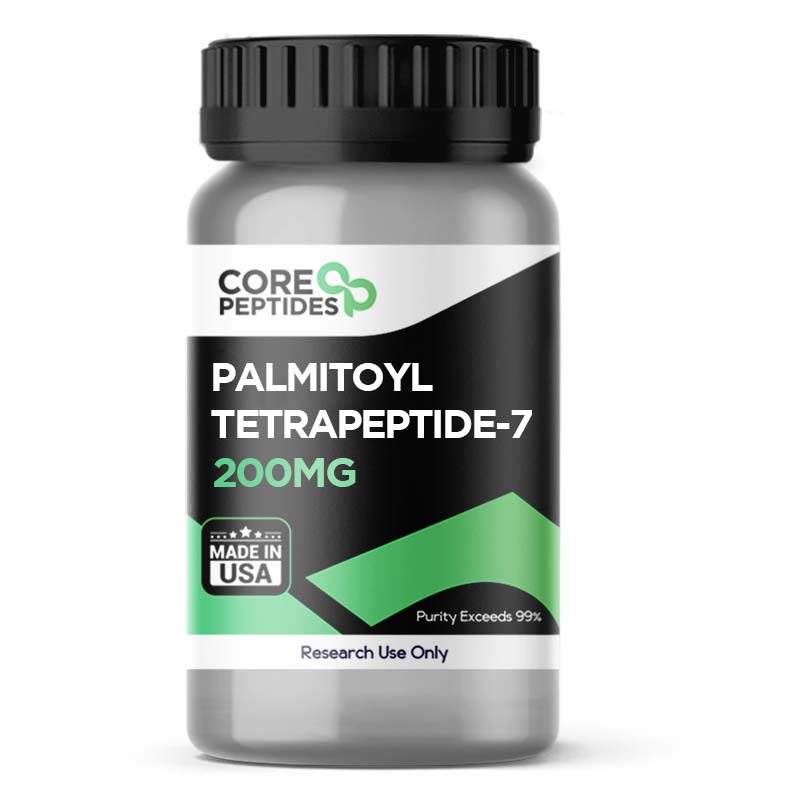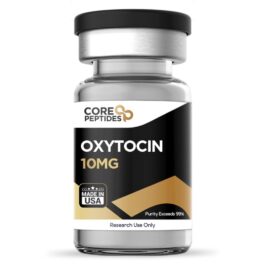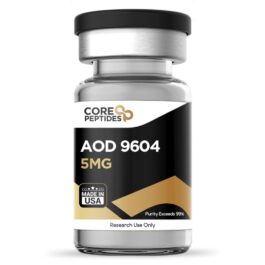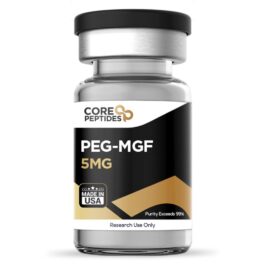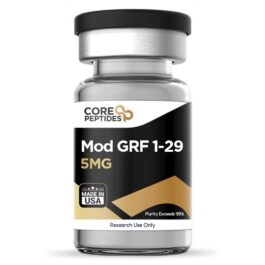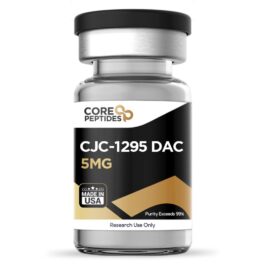Palmitoyl Tetrapeptide-7 (200mg)
$197.00
Size: 200mg
Contents: Palmitoyl Tetrapeptide-7
Form: Lyophilized powder
Purity: >99%
SKU: P-PAL-TETRA-7
FREE Shipping on $200+ orders
Discount per Quantity
| Quantity | Discount | Price |
|---|---|---|
| 5 - 8 | 5% | $187.15 |
| 9 + | 10% | $177.30 |
Palmitoyl Tetrapeptide-7
Palmitoyl Tetrapeptide-7 is a small peptide composed of four amino acids: palmitoyl, glycine, glutamine, and arginine.(1) It is a synthetic peptide analog of the natural matrikine peptide, which is considered to play a vital role in regulating extracellular matrix (ECM) turnover and other related cellular activities.
Initial research suggests that the Palmitoyl Tetrapeptide-7 peptide may stimulate the synthesis of ECM components, such as collagen and elastin, and may inhibit the production of pro-inflammatory cytokines. It has also been hypothesized to modulate gene expression involved in ECM remodeling, cell proliferation, and inflammation.(2)
Moreover, Palmitoyl Tetrapeptide-7 may function by suppressing the activity of interleukin-6 (IL-6), a pro-inflammatory cytokine that plays a role in the apoptosis of skin cells (cell aging and death) and inflammation. IL-6 secretion is considered to increase with time, leading to the degradation of the ECM, and resulting in a loss of flexibility and structural integrity in the skin barrier.
Chemical Makeup(1)
Molecular Formula: C34H62N8O7
Molecular Weight: 694.9 g/mol
Other Known Titles: Pal-Gly-Gln-Pro-Arg-OH, N-Palmitoylrigin , Palmitoyl-GQPR, Rigin
Research and Clinical Studies
Palmitoyl Tetrapeptide-7 Mechanism of Action
Based on animal studies, Palmitoyl Tetrapeptide-7 has been suggested to potentially inhibit the activity of matrix metalloproteinases (MMPs) in animal models.(3) MMPs are a group of enzymes that may degrade ECM proteins during normal tissue growth. By downregulating MMP activity, Palmitoyl Tetrapeptide-7 may prevent ECM damage and may allow cells to restore and maintain the ECM. More specifically, the peptide might stimulate the production of key components of the skin's extracellular matrix, such as laminin IV and V as well as collagen VII. Laminins may be essential for the structural stability and integrity of the basement membrane, while collagen VII is considered critical in anchoring fibrils that connect the dermis to the epidermis. By potentially enhancing the production of these molecules, Palmitoyl Tetrapeptide-7 might contribute to the maintenance and repair of the skin barrier, thereby improving skin tissue resilience. The peptide is also thought to potentially decrease IL-6 secretion, a cytokine that is believed to play a pivotal role in promoting inflammation. By possibly reducing the levels of IL-6, Palmitoyl Tetrapeptide-7 may act to diminish inflammation, particularly following UVB exposure, which is considered to trigger inflammatory responses in the skin.(4)
Palmitoyl Tetrapeptide-7 and Oral Conditions
Given the inhibitory potential of the peptide on matrix metalloproteinases (MMPs), research teams have thought to examine the potential action of Palmitoyl Tetrapeptide-7 in mitigating the symptoms of certain oral conditions. MMPs enzymes may break down extracellular matrix (ECM) proteins, including those in the oral cavity. While these enzymes are considered to play a role in various physiological and pathological processes, including tissue repair, wound healing, and inflammation, excessive MMP activity might result in tissue damage and may cause various oral diseases, such as periodontitis, caries, and oral cancer. Studies have also suggested that MMP activity may be upregulated in some oral conditions, including periodontitis, characterized by the destruction of periodontal tissues. The possible inhibition of MMP activity by Palmitoyl Tetrapeptide-7 might potentially prevent or slow the progression of periodontitis (and other oral ailments) by preserving the integrity of the ECM.(3)
Palmitoyl Tetrapeptide-7 and Skin Damage
Studies suggest that the peptide may stimulate the synthesis of collagen, a key component of the extracellular matrix in the skin, and may produce anti-inflammatory action, which might reduce damage caused by environmental factors such as UV radiation and pollution.
Research has suggested that combining Palmitoyl Tetrapeptide-7 with Palmitoyl Oligopeptide (Matrixyl 3000) may synergistically stimulate collagen production and reduce inflammation. This synergy, which the study describes as "dramatic," may help improve skin texture and reduce the depth and length of wrinkling that may occur along the stratum corneum of the epidermal barrier.(5)
According to the studies, “Matrixyl 3000 is a synergistic combination of two skin-active peptides, Palmitoyl oligopeptide and Palmitoyl-tetrapeptide-7, which appears promising based on the preliminary data from the manufacturer… However, it remains to be proven effective by independent published clinical studies.”
As discussed, Palmitoyl Tetrapeptide-7 may be particularly targeting stimulation of collagen type VII.(4) Collagen type VII is posited to be a vital component of the skin tissues' architecture, primarily contributing to the stability and structural integrity of the dermal-epidermal junction. It is thought to play a key role in anchoring fibrils that connect the outer epidermis to the deeper dermis. This specific collagen might form a crucial part of the basement membrane, potentially serving as a scaffold that maintains the structural cohesion between these skin layers. The presence and functionality of collagen type VII are considered essential for the prevention of blistering disorders, which occur when there is a breakdown in this connection between the dermis and epidermis. Moreover, collagen type VII may also play a role in skin tissue healing. This type of collagen could be critical in skin recovery and repair by possibly facilitating the reattachment of the epidermis to the underlying tissue after an injury. It is posited that enhancing the synthesis of collagen VII might improve wound healing outcomes, particularly in environments compromised by age or dermal afflictions.
Palmitoyl Tetrapeptide-7 and Wrinkle Depth
The peptide, sometimes classified as an “anti-aging” compound, is so named due to its perceived potential action and enhancement of integral protein production within the skin, as discussed above. In a randomized, double-blind, placebo-controlled clinical study, 20 research models were presented with a cream containing Palmitoyl Tetrapeptide-7 for 12 weeks. The cream was applied twice daily to observable wrinkles along the skin.
At the end of the study period, the researchers reported that the cream containing Palmitoyl Tetrapeptide-7 appeared to have reduced the depth and length of the wrinkles compared to the placebo cream.(6) The researchers also observed an apparently significant increase in skin elasticity in the group that received the Palmitoyl Tetrapeptide-7 cream.
In another study, 20 research models were exposed to the peptide compound twice a day for four weeks, and instrumental measurements were taken to assess the improvement of biomarkers of cell aging and ECM decline. The study reported an apparent reduction in fine wrinkles by 5.97% after two weeks and 14.07% after four weeks, and a reported increase in skin elasticity by 6.81% after two weeks, and 8.79% after four weeks. Dermal density was reportedly increased by 16.74% after two weeks, and 27.63% after four weeks.(7)
Palmitoyl Tetrapeptide-7 is available for research and laboratory purposes only. Please review and adhere to our Terms and Conditions before ordering.
References
- National Center for Biotechnology Information (2023). PubChem Compound Summary for CID 10078408, Palmitoyl tetrapeptide-7.
- Mondon P, Hillion M, Peschard O, Andre N, Marchand T, Doridot E, Feuilloley MG, Pionneau C, Chardonnet S. Evaluation of dermal extracellular matrix and epidermal-dermal junction modifications using matrix-assisted laser desorption/ionization mass spectrometric imaging, in vivo reflectance confocal microscopy, echography, and histology: effect of age and peptide applications. J Cosmet Dermatol. 2015 Jun;14(2):152-60. doi: 10.1111/jocd.12135. Epub 2015 Mar 27. PMID: 25817264. https://pubmed.ncbi.nlm.nih.gov/25817264/
- Sorsa T, Tjäderhane L, Salo T. Matrix metalloproteinases (MMPs) in oral diseases. Oral Dis. 2004 Nov;10(6):311-8. doi: 10.1111/j.1601-0825.2004.01038.x. PMID: 15533204. https://pubmed.ncbi.nlm.nih.gov/15533204/
- Resende, Diana I S P et al. “Usage of Synthetic Peptides in Cosmetics for Sensitive Skin.” Pharmaceuticals (Basel, Switzerland) vol. 14,8 702. 21 Jul. 2021, doi:10.3390/ph14080702
- Matrixyl 3000 (palmitoyl oligopeptide & palmitoyl tetrapeptide-7): Back to the future of skin care.
- Marta Salvador-Ferreira et al. Trending Anti-Aging Peptides. MDPI Journal, Vol 7, Issue 4. https://www.mdpi.com/2079-9284/7/4/91
- Hahn Hyung Jin et al. Instrumental evaluation of anti‑aging effects of cosmetic formulations containing palmitoyl peptides, Silybum marianum seed oil, vitamin E and other functional ingredients on aged human skin, Experimental and Therapeutic Medicine, Jun 2016.
